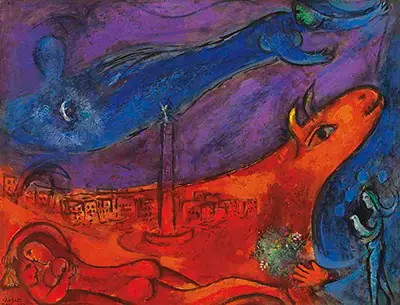The Place de la Bastille is pictured in the centre of this scene, with the structure of the July Column reaching up into the sky. It marks the former location of the Bastille prison, a key element to the events of the July Revolution which took place in 1830 and hold a huge part in the telling of the history of the French Republic. Naturally, Chagall does not choose to capture this location in a realist or historically accepted manner, but rather takes the monument and surrounding buildings into his world of dreams and bright colour. Few artworks better display his preference for bright tones in proximity to each other than The Bastille, which specifically draws on tones of orange/red, purple and blue. These appear many times within his career, alongside also a frequent use of yellow and green as well.
Beyond the colours, there is much to see within this painting, which was later converted into a successful lithograph release. An animal's head reaches out into the right hand side, whilst its body decorates the main part of the scene with an abundance of bright orange. The cityscape is then painted into that background tone, with a couple embraced together in the foreground. An arm comes in from the right, with a bunch of flowers offered. There are other figures added into the area, who merge into the blue tones. Above, an angel flies above, stretching right across the whole width of the painting, which is entirely typical of the artist. Most elements of his style can be found within this piece, and it is easy to understand how the full 50 copies were sold on relatively quickly.
To illustrate the success of the artist during his own lifetime, a museum was set up in his name in 1972. It is particularly rare for a significant gallery or museum to be set up in an artist's name whilst they are still alive. Institutions devoted to a single artist tend to come out of a large bequething from the artist, normally to the state, and then these arise from the need to present the various items to the public as part of the agreed donation. Chagall was actually in his prime when the Nice gallery was set up, though he must have been incredibly honoured to have seen the building put together and launched whilst his career was still progressing well.
